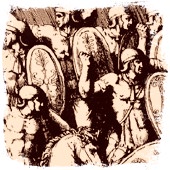

The use of ties is very ancient and goes back to the Roman Empire when the focal was used. It is visible in certain portrayals of Roman legionaries battling against the Dacia barbarians (II Century A.D.).
 This is confirmed in the writings of some authors like Martial who refers to ties and says that they were made of wool or linen.
This accessory disappeared during the Middle Ages.
Traces and vestiges of this accessory completely disappeared and today it is commonly believed that the invention of the tie dates back to the Croatian army soldiers who served in France during the wars of Louis XIV.
It was during the Thirty Year's War when France and Sweden were fighting against the German Empire that mercenaries coming from today's Croatia, Bosnia and Hungary were first seen wearing scarf-like ties. Proof also lies in the etymology of the word in various languages: the French "cravate", the Italian "cravatta", the German "krawatte", the Spanish "corbata", and the Serbian-Croatina "kravatu".
This is confirmed in the writings of some authors like Martial who refers to ties and says that they were made of wool or linen.
This accessory disappeared during the Middle Ages.
Traces and vestiges of this accessory completely disappeared and today it is commonly believed that the invention of the tie dates back to the Croatian army soldiers who served in France during the wars of Louis XIV.
It was during the Thirty Year's War when France and Sweden were fighting against the German Empire that mercenaries coming from today's Croatia, Bosnia and Hungary were first seen wearing scarf-like ties. Proof also lies in the etymology of the word in various languages: the French "cravate", the Italian "cravatta", the German "krawatte", the Spanish "corbata", and the Serbian-Croatina "kravatu".
 The influence of the Croatian soldiers was so important that starting from the middle of the XVII Century portraits of gentlemen were all with this neck accessory which was considered a sign of elegance and distinction.
Throughout European royal courts the use of the tie became mandatory and no important person could do without using it.
The influence of the Croatian soldiers was so important that starting from the middle of the XVII Century portraits of gentlemen were all with this neck accessory which was considered a sign of elegance and distinction.
Throughout European royal courts the use of the tie became mandatory and no important person could do without using it.
|
The king of France liked to tie his own knot and would only ask for only his valet's opinion or small touch up.
 England adopted ties a little later reaching unprecedented levels of luxury thanks to the very precious embroidery which they had made in Venice.
Up to this time the tie was an exclusively masculine accessory but during the French Revolution the use of the tie spread to the merveilleuses, those women who still today are noted for their eccentricity in clothing, also inspired by ancient Greece and Rome.
After the revolution the incroyables made a decidedly exaggerated use of the tie.
The use of ties returns to its exclusively masculine use around 1830 and was reused by women at the end of the XIX Century with the advent of the suit.
The famous feminist Amelia Bloomer loved to wear masculine ties.
England adopted ties a little later reaching unprecedented levels of luxury thanks to the very precious embroidery which they had made in Venice.
Up to this time the tie was an exclusively masculine accessory but during the French Revolution the use of the tie spread to the merveilleuses, those women who still today are noted for their eccentricity in clothing, also inspired by ancient Greece and Rome.
After the revolution the incroyables made a decidedly exaggerated use of the tie.
The use of ties returns to its exclusively masculine use around 1830 and was reused by women at the end of the XIX Century with the advent of the suit.
The famous feminist Amelia Bloomer loved to wear masculine ties.
 Praise to the tie has also been expressed by Gabriele d'Annunzio, Lord Brummel, Oscar Wilde and various other modern "elegant" people.
Futurists wore an untied tie, the Surrealists (from Magritte to Dali) dedicated ties a place of honor on their portraits.
Praise to the tie has also been expressed by Gabriele d'Annunzio, Lord Brummel, Oscar Wilde and various other modern "elegant" people.
Futurists wore an untied tie, the Surrealists (from Magritte to Dali) dedicated ties a place of honor on their portraits.
|
Other famous artists like Baj and Munari made ties in various materials and the sculptor Domenico Gnoli is famous for a large bronze statue representing " knotted tie without a neck".
 Today most of the suits presented by the most important designers are accompanied with ties , a must, to complement the attire of a modern and elegant man.
Very recently ties have reappeared again in women's wardrobes and a period of growing use by women is expected in the next few years.
Tie collecting is spreading rapidly even if only until recently it was the hobby of very few people.
Today most of the suits presented by the most important designers are accompanied with ties , a must, to complement the attire of a modern and elegant man.
Very recently ties have reappeared again in women's wardrobes and a period of growing use by women is expected in the next few years.
Tie collecting is spreading rapidly even if only until recently it was the hobby of very few people.

Future: elegant accessory not to be ignored which will never be out of style because it is the only means men have to express their imagination, personality and daily humour just like a banner of their inner self. There will always be circumstances, roles, professions and occasions demanding ties: The tie will always represent a gift, that if properly chosen can express with great precision the type of sentiment to be transmitted (affection, respect,gratitude, etc.) |